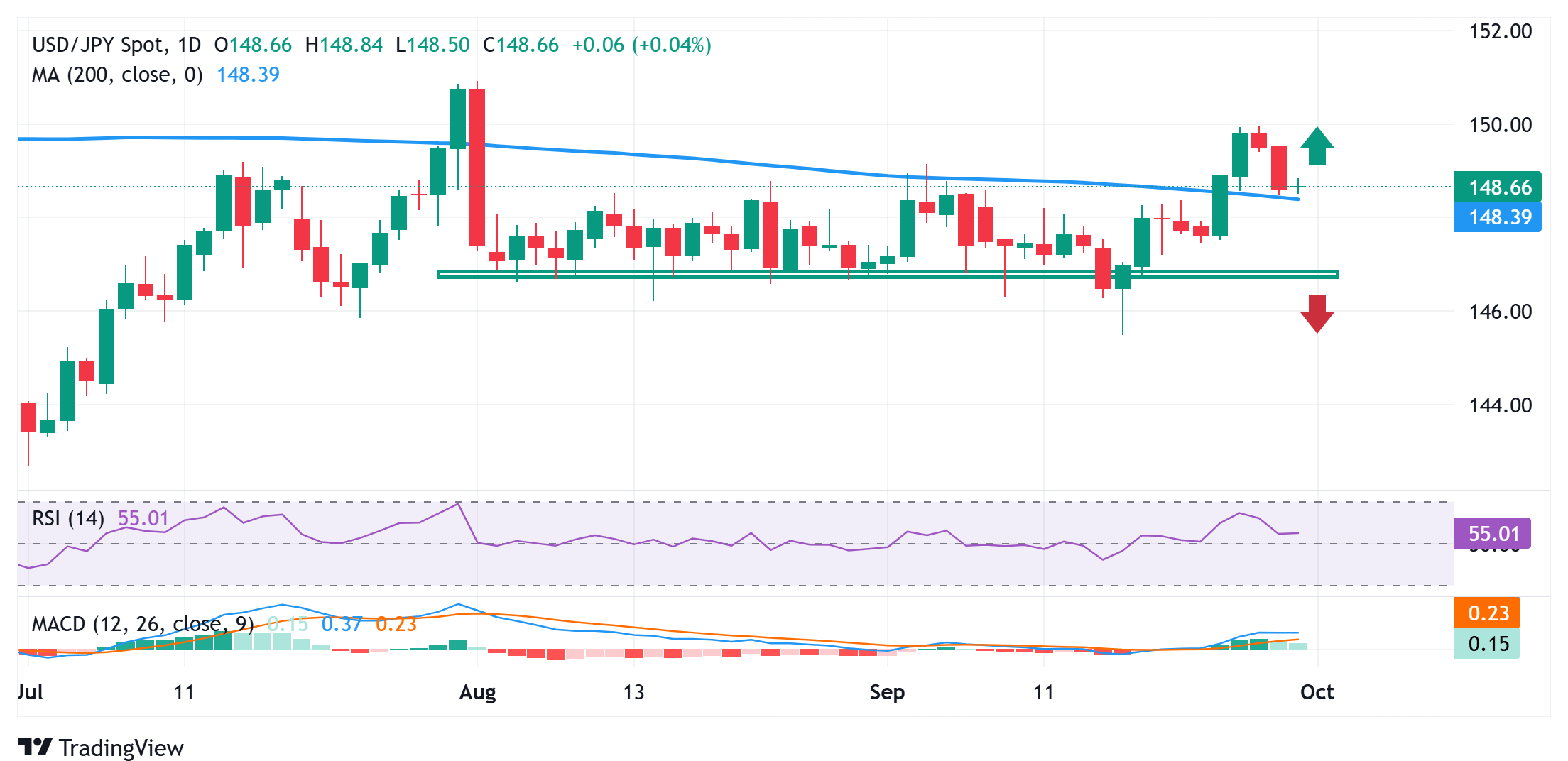Created
: 2025.09.30














![]() 2025.09.30 12:12
2025.09.30 12:12
The Japanese Yen (JPY) edged lower during the Asian session on Tuesday after the Bank of Japan (BoJ) Summary of Opinions indicated a divided board over the need for an immediate policy tightening. Moreover, the disappointing release of Industrial Production data and Retail Sales figures from Japan, along with the underlying bullish tone across the global financial markets and trade uncertainties, undermine the safe-haven JPY. Adding to this, a modest US Dollar (USD) uptick assists the USD/JPY pair to gain some positive traction and stall its recent retracement slide from the vicinity of the 150.00 psychological mark, or its highest level since early August, touched last Friday.
Traders, however, seem convinced that the BoJ will stick to its policy normalization path and are still pricing in the possibility of a rate hike in October. This marks a significant divergence in comparison to bets that the US Federal Reserve (Fed) will lower borrowing costs twice by the end of this year, which should limit deeper losses for the lower-yielding JPY. Meanwhile, dovish Fed expectations, along with the risk of a potential US government shutdown, might keep a lid on any meaningful appreciation for the USD and the USD/JPY pair. This warrants caution before positioning for the resumption of the pair's recovery from the lowest level since July 7 touched earlier this month.

The USD/JPY pair finds some support and defends a technically significant 200-day Simple Moving Average (SMA). Adding to this, oscillators on the daily chart - though they have been losing traction - are holding in positive territory. This, in turn, favors bullish traders and backs the case for additional gains. Any further move up, however, is likely to confront a hurdle near the 149.00 mark. A sustained strength beyond will reaffirm the positive outlook and allow spot prices to make a fresh attempt to conquer the 150.00 psychological mark with some intermediate resistance near the 149.40-149.45 region.
On the flip side, weakness below the 200-day SMA, currently pegged near the 148.40 region, could pave the way for a slide towards the 148.00 round figure. Some follow-through selling will negate any near-term positive bias and make the USD/JPY pair vulnerable to accelerate the slide towards the 147.50 region en route to the 147.20-147.15 zone. This is followed by the 147.00 mark, which, if broken decisively, might shift the near-term bias in favor of bearish traders.
The Bank of Japan (BoJ) is the Japanese central bank, which sets monetary policy in the country. Its mandate is to issue banknotes and carry out currency and monetary control to ensure price stability, which means an inflation target of around 2%.
The Bank of Japan embarked in an ultra-loose monetary policy in 2013 in order to stimulate the economy and fuel inflation amid a low-inflationary environment. The bank's policy is based on Quantitative and Qualitative Easing (QQE), or printing notes to buy assets such as government or corporate bonds to provide liquidity. In 2016, the bank doubled down on its strategy and further loosened policy by first introducing negative interest rates and then directly controlling the yield of its 10-year government bonds. In March 2024, the BoJ lifted interest rates, effectively retreating from the ultra-loose monetary policy stance.
The Bank's massive stimulus caused the Yen to depreciate against its main currency peers. This process exacerbated in 2022 and 2023 due to an increasing policy divergence between the Bank of Japan and other main central banks, which opted to increase interest rates sharply to fight decades-high levels of inflation. The BoJ's policy led to a widening differential with other currencies, dragging down the value of the Yen. This trend partly reversed in 2024, when the BoJ decided to abandon its ultra-loose policy stance.
A weaker Yen and the spike in global energy prices led to an increase in Japanese inflation, which exceeded the BoJ's 2% target. The prospect of rising salaries in the country - a key element fuelling inflation - also contributed to the move.
![]()
Created
: 2025.09.30
![]()
Last updated
: 2025.09.30

FXStreet is a forex information website, delivering market analysis and news articles 24/7.
It features a number of articles contributed by well-known analysts, in addition to the ones by its editorial team.
Founded in 2000 by Francesc Riverola, a Spanish economist, it has grown to become a world-renowned information website.
We hope you find this article useful. Any comments or suggestions will be greatly appreciated.
We are also looking for writers with extensive experience in forex and crypto to join us.
please contact us at [email protected].
Disclaimer:
All information and content provided on this website is provided for informational purposes only and is not intended to solicit any investment. Although all efforts are made in order to ensure that the information is correct, no guarantee is provided for the accuracy of any content on this website. Any decision made shall be the responsibility of the investor and Myforex does not take any responsibility whatsoever regarding the use of any information provided herein.
The content provided on this website belongs to Myforex and, where stated, the relevant licensors. All rights are reserved by Myforex and the relevant licensors, and no content of this website, whether in full or in part, shall be copied or displayed elsewhere without the explicit written permission of the relevant copyright holder. If you wish to use any part of the content provided on this website, please ensure that you contact Myforex.
Myforex uses cookies to improve the convenience and functionality of this website. This website may include cookies not only by us but also by third parties (advertisers, log analysts, etc.) for the purpose of tracking the activities of users. Cookie policy